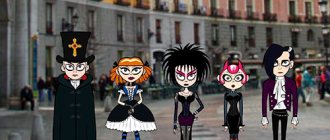At all times, people have united into separate groups with common hobbies and interests. Often their views went beyond traditional social norms.
Mass culture focuses on the majority and satisfies the most popular needs. Subcultures have become an outlet for people who do not share generally accepted paradigms.
History and origin of the term “subculture”
In the 20th century the number of emerging communities united along some basis increased, and then this phenomenon received the name subculture.
The term was coined by David Riesman, an American sociologist, to refer to people who deliberately adhere to minority views. “Sub” means “under”, respectively, otherwise the word is translated as “subculture”.
Today, the concept of “subculture” is actively used in sociology, anthropology and other social sciences.
Features of the subculture
A subculture can be distinguished by its characteristic features:
- a small number of followers (unlike traditional culture, each subculture unites a limited number of people with a similar vision of the world);
- passion for one idea or one type of activity, on the basis of which the community was created;
- a uniform style of clothing, behavior, slang, symbolism (not mandatory, but a very common condition);
- as part of subcultures, as a rule, people are uncommunicative and withdrawn among ordinary people;
- a subculture does not contradict the existing culture, unlike counterculture, but exists in parallel with it.
A certain subculture may lack some features, and instead of them there will be something else.
Main types of youth subcultures
| Subculture name | Origin time | Peculiarities |
| Hippie | 1960 | Young people opposed philistine life, professed the ideas of “non-resistance to evil through violence,” and adhered to pacifist views. A characteristic feature was a penchant for creativity. |
| Rastafarians | 1960 | Rastafarians are characterized by a love of marijuana and reggae. They do not accept tobacco and alcohol, do not eat meat and will introduce a healthy lifestyle. They are engaged in art, and their symbol is “dreadlocks” and a red-yellow-green cap - “Latifika”. |
| Punks | 1970 | Punks do not recognize any authority and are anarchists. This explains their symbol, the letter “A.” On the street, punks immediately stand out from the crowd thanks to their distinctive mohawk hairstyle (a strip of long hair that stands vertically upward on a completely shaved head). |
| Goths | 1970 | The Goths use Egyptian, Celtic and Christian symbolism, as well as occult symbols - pentagrams, death symbols or eight-pointed stars. They always wear special makeup. With the help of cosmetics, they give the face a deathly pale, almost white tint. Eyes are outlined with black eyeliner, lips and nails are also painted black. |
| Emo | 1980 | This style is characterized by crying and moaning, squealing and whispering that breaks into a scream. |
| Majors | 1980 | Young people belonging to this subculture live for their own pleasure and have no shortage of money. They have the best clothes and shoes, which were almost impossible to get in Soviet times, as well as free access to their parents’ car. |
| Yuppie | 1980 | This is a youth subculture whose members have highly paid jobs and lead an active business lifestyle. They have an appropriate clothing style, they know a lot about fashion, and they take care of their bodies. |
| Hackers | 1990 | They are characterized by individuality and a lack of corporate spirit, since freedom is the most important thing in life. They disable other people's websites and servers, crack passwords and obtain secret information. |
Hippie
They belong to one of the oldest youth subcultures. It was formed in the mid-60s of the 20th century in San Francisco.
Young people spent their time in discussions and polemics, played music and indulged in free love. Alcohol and drugs at parties were considered commonplace.
Hippies have no attachment to home; they constantly travel without any means of subsistence. They worship freedom, love flowers and walking barefoot. The ideas of this movement are still alive.
Rastafarians
This subculture is somewhat similar to hippies. Rastafari is a special religion of the universal god Jah. Participants in this movement are convinced pacifists who categorically condemn racism.
Speaking about the features of the Rastafarian movement in Russia, we can say that such associations mainly include young fans of reggae music.
Punks
This subculture began its development in the mid-1970s of the 20th century in England—it was during this period that the country experienced a severe economic crisis. Young people lived under the motto: “No future!” and behaved in strict accordance with the low standard of living. They are absolutely sure that it is absolutely impossible to change their life for the better, and therefore they have given up on life, career and education.
The clothing style of such young people corresponds to their way of thinking and behavior - preference is given to stale T-shirts and jeans with holes and scuffs. The picture is complemented by a love of drinking, fighting and drugs due to the lack of other hobbies.
In 1979, the punk movement penetrated into the USSR. One of its first adherents were famous rock musicians of St. Petersburg Andrei Panov and Viktor Tsoi.
Goths
The date of birth of Gothic is considered to be the end of the 70s of the 20th century. The basis of this subculture was post-punk. The first goths adopted a lot from the punks, making black the main color of their clothes (there could be minor splashes of white or red). Silver jewelry complemented the clothes.
The very first formations included young people who were fans of gothic musical groups. Subsequently, the Goths developed their own lifestyle, they acquired their own mentality and hierarchy.
The Goth subculture still exists today. The image of movement participants is very complex and is formed from specific clothes, shoes, accessories, hairstyles and makeup.
Emo
The emo movement, which is part of the youth subcultures, is also associated with music. The style of music corresponds to the name of the movement, which means "emotional". The melody is based on strong emotions that are acutely felt in the vocalist's voice.
The music of this movement has several types:
- emo rock and screamo;
- cyber-emo and French-emo;
- punk-emo and hardcore San Diego, etc.
Fans of such music form a separate subculture and are called emo kids. A characteristic external feature of such youth is bright clothing, hairstyle and makeup.
Majors
During the period of “developed socialism” a new direction appears among young people. “Golden” boys and girls are not interested in everyday problems and the difficulties of life, since all troubles are quickly and quietly resolved by their parents. This subculture originated in the late seventies and is close to yuppies or kogars.
They flaunt fashionable equipment and foreign technology. Majors move through life easily, love and know how to relax (often at the official dacha given to their parents). They are among the few who can travel abroad with relatives to live in capitalist countries.
The level of the major is related to the position of his parents. Personal achievements at school or university are also important. He communicates only with his equals, but simply does not notice the rest, or treats them patronizingly or contemptuously.
Yuppie
Such young people do not demonstrate their success, do not flaunt their wealth and do not waste money. They are restrained and self-confident; strict, perfectly tailored suits speak for themselves.
The life of a yuppie is known only to a narrow circle of insiders and is often described in magazines published at their own expense.
Hackers
This is a youth subculture that includes programmers and computer users, who are characterized by an offensive line of behavior on the Internet.
Varieties of subcultures
Subcultures can be classified based on their association.
- Musical. A musical direction is used as a unifying factor: a genre of music or dance, a passion for a particular performer or musical group.
- Gaming. People who are passionate about one game, characters from games. The community can consist of both players and their fans.
- Sports. Such subcultures are formed around a specific sports discipline; this can also include not only athletes, but also fans.
- Philosophical-behavioural. In these groups there are people with certain beliefs and the same attitude towards the world.
- Stylish. Despite the fact that many subcultures use a certain style of appearance, in this case appearance is the main factor in the formation of a community.
- Hobby. Such subcultures are formed naturally, since people who prefer fishing, embroidery or motorcycles regularly collide and begin to communicate, since they can only discuss things that are important to them among themselves.
- Internet subcultures. Communities formed in the global information network. As a rule, their sign of unification is not relevant offline, so such people also most often communicate using electronic devices. Internet groups have the most diverse composition in terms of age and gender.
- Professional. Unites people of the same profession.
You may also be interested in: Microshading - what is it and how is it different from microblading?
There are many more types of subcultures, the bulk are listed, but many cannot be combined into a large group.
Problems of subcultures
Attitude to a certain movement - subculture - is an attempt to find oneself, a step towards growing up and understanding the world. Some teenagers subsequently easily return to their usual way of life in society, while others, on the contrary, experience difficulties in communicating with the outside world.
Drugs are a serious problem and are often easily distributed among young people. Particularly impressionable people, under the influence of the atmosphere of a certain subculture, can commit suicide. Such young people should be under the supervision of more reasonable and “down-to-earth” comrades or adults.
Youth subcultures have always existed and will always exist. Some of them quickly dissolve in time, others pass through the years to the present day. It is important that fragile young minds have the support and understanding of their elders, who are ready to help in difficult times and direct their energy in a creative direction.
Examples of popular subcultures
- Anime fans are the self-name of a subculture of anime fans. Japanese animation has gained popularity on all continents, and many communities have been formed in its honor, both on the Internet and in real life. Anime fans organize meetings and festivals where they sell things with anime symbols, and cosplay their favorite characters (dress up as them). This usually includes schoolchildren and teenagers, but many adults also enjoy getting into anime culture.
- Roleplayers are fans of live-action role-playing games dedicated to universes from fantasy books, films, and historical eras. These people are passionate about creating historical (or other) reconstructions, recreating events, sewing authentic costumes, and acting out scenes in compliance with game protocol.
- Workout – “street gymnastics”. Workout athletes engage in amateur sports on the streets. As a rule, these are not professional athletes, but sometimes their successes amaze even professionals.
- Gamers are passionate fans of computer games, or one game at a time. Among gamers, competitions are periodically held in certain games, some of which led to the creation of e-sports, with many spectators.
- Goths – have an interest in Gothic culture. In this subculture, attention to the aesthetics of death occupies a special place, but unlike Satanists, there is no call for violence. Goths prefer black clothing, gloomy slogans, and demonstrate a passion for mysticism and horror.
- Emo - gained popularity almost at the same time as the Goths (late 20th century), as a result of which they began to be opposed to them. They are named after the musical movement of the same name. Philosophy is freedom of expression of emotions. Emo is often associated with sadness, tears and suicidal thoughts, but this is not fair. Freedom to express joyful emotions is also in emo culture. A distinctive feature of her appearance is the combination of black and pink colors in clothes, hairstyle, and accessories.
- Bikers are motorcycle lovers. Motorcycles are an important part of a biker's life and a source of inspiration. Bikers attach great importance to the condition of their motorcycle, are interested in news in this area, and communicate in their environment. We often see a biker in movies, in the form of a strong man with a beard, wearing black leather clothes and a bandana. This is close to reality, of course, this image may differ from reality.
- Rockers are similar in style to bikers; often these people belonged to two subcultures at the same time. This includes fans of heavy music and rock.
You may also be interested in: Gratitude and gratitude - what are they and the differences
Subcultures. Concept, history, features of youth subcultures. article on the topic
municipal budgetary institution of additional education
Anzhero-Sudzhensky urban district
"Station for young tourists"
Article
SUBCULTURES.
CONCEPT, HISTORY OF APPEARANCE, FEATURES OF YOUTH SUB-CULTURES.
Author: Migonkina Zilya Raisovna,
additional education teacher
Anzhero-Sudzhensk
2018 school year year
Introduction
In modern school and student reality, teachers often have to deal with what they consider unusual students. He expresses himself incomprehensibly, looks strange in appearance: shaved bald, hair dyed in all colors of the rainbow, strange manners, makeup, tattoos, clothes... What is this? How to respond to such pupils and students? Should we “shy away” from them in horror, or should we just take a closer look, listen and understand how students live, what’s going on in their souls? Perhaps this is just an attempt to stand out from the general environment. Each teacher decides these questions for himself. But it is possible to help him understand the peculiarities of such a phenomenon as a subculture.
This article examines a special part of public culture – subcultures. Concept, history and reasons for the emergence of a subculture. As well as the classification of subcultures. But, the subculture called “alternatives” is described in most detail.
What is a subculture? Subculture is a set of values and practices accumulated by a group of people, united by specific interests that determine their worldview, accumulated by a certain worldview. Subculture is a sovereign integral formation, part of public culture. From the point of view of cultural studies, a subculture is such associations of people that do not contradict the values of traditional culture, but complement it.
A subculture may differ from the dominant culture in language, behavior, clothing, etc. The basis of a subculture may be a style of music, a way of life, or certain political views. Some subcultures are extreme in nature and demonstrate protest against society or certain social phenomena. Some subcultures are closed in nature and strive to isolate their representatives from society. Sometimes subcultures develop and become elements of a single culture of society. Developed subcultures have their own periodicals, clubs, and public organizations.
A youth subculture is understood as the culture of a certain young generation that has a common lifestyle, behavior, group norms, values and stereotypes.
History of the subculture
Non-normative (deviating from accepted social norms, antisocial) behavior of young people first became the object of attention of scientists in the USA in the 30-50s. XX century. Sociologists, psychologists, and lawyers have studied the emergence and functioning of youth gangs in big cities, primarily Chicago. They looked at the non-normative, that is, non-standard from the point of view of social norms, behavior of young people. Research has shown that members of such gangster associations live in accordance with their own rules and norms, which are a deviation from the basic socio-cultural norm. It was to them, these associations, that the concept of “subculture” was first applied. In this concept, a subculture is a community where atypical - “asocial” behavior is considered as conformity, that is, the norm. A subculture began to be called a subsystem of society that is not recognized by society as a whole, primarily by state authorities.
As we see, initially the approach to subcultures was purely sociological. Then interest in this phenomenon moves to a broader sphere of humanitarian interests - the sphere of cultural studies.
After the Second World War, the term “youth subculture” came into use among sociologists and began to be used not only in relation to criminal groups, but also to all cultural phenomena associated with youth. It was noted that growing prosperity leads to an increase in the purchasing power of young people, and this in turn gives rise to the emergence of a new, independent market for goods and services aimed at young buyers. It has been called a "teen culture breakthrough." However, during this period, deviations from the basic norms and values of society among young people were insignificant and many researchers, on this basis, denied the existence of the concept of “youth culture”, arguing their position by the fact that powerful means of influence and control over the lifestyle of the young are concentrated in the hands of the older generation generations.
But those who viewed adolescence as the beginning of a new intracultural process turned out to be right. The production of widely available “cultural goods” (pop music, fashion, etc.) has led to the fact that teenagers have become an international style movement, producing and consuming not only a variety of fashion and music. The youth subculture gradually differentiated, various movements arose in it, which were no longer associated only and not so much with fashion and music, but with socio-political views - this process swept the culture in the 60-70s. Then they started talking about the “conflict of generations”, and as a result, interest in research studying this problem sharply increased.
The concept of youth subculture
The concept of youth subcultures was initially applied by sociologists in Western Europe and the United States only to the criminal environment. Gradually, the content of the concept expanded and began to be used in relation to the norms and values that determine the behavior of a certain social group of young people - thus, the concept of “subculture” was associated with the concept of “cultural paradigm”, that is, that set of ideas and rules that provides a kind of matrix of behavior in different situations. However, while studying this matrix, scientists came across facts that forced them to question some ideas that had previously seemed obvious. For example, the English scholar Grant McCracken, in his widely acclaimed book Flood: A Culture Born of Turmoil, describes his conversations with various groups of teenagers (goths, punks and skaters). The researcher discovered that differences in clothing, fashion, etc., that is, external differences, indicate internal differences, namely, differences in values and their gradations. Some observers, he noted, believe that the actions of adolescents are guided only by the desire to achieve recognition from their peers, and everything else (clothing, language, musical tastes, behavior, etc.) is just “monkeying”, necessary to belong to a group. This point of view comes from the idea of youth culture as a natural sequence.
Another point of view comes from the fact that subculture represents a confrontation, which consists in the fact that the reason for diversity in the teenage world is an expression of inter-age and class hostility. This position is developed, for example, by the book of American researchers “The Language of Youth Subcultures: Social Identification in Action” (New York, 1995). Teenagers enter a hostile world. This point of view was defended, in particular, by the authors of one of the first significant books devoted to youth subcultures - the Englishmen Stuart Gell and Tony Jefferson in the book “Confrontation through rituals: youth subcultures in post-war Britain”, published in London in 1976.
Reasons for the emergence of the subculture
Why do subcultures arise?
The most common answer is this: to resolve contradictions in the mainstream culture if it fails to provide the new generation with a valid ideology. A subculture takes shape in its own style of behavior, in language, clothing, and in rituals that are capable of creative development.
The theory of subcultures as a scientific discipline tries to determine the relationship between the “main” culture and “deviations”. She works in the conceptual field of cultural studies, based on specific sociological studies and other humanities disciplines. Marxist theory denies subcultures, considering youth subcultures as an ideology designed to mask the antagonistic contradictions of capitalist society and replace them with confrontation between generations.
The views of supporters of the theory of social conflict are close to Marxist.
Social action theorists emphasize the behavior of the individual in his contacts with others. In this understanding, subcultures are considered as a system that regulates the implementation of the interests and needs of young people in society.
Each of us has happened to walk down the street, ride the subway, or just watch TV and see people who are somehow different from others. These are the informals - representatives of modern subcultures.
The very word “informal”, “informal” means unusualness, brightness and originality. An informal person is an attempt to show his individuality, to say to the gray masses: “I am a person,” to challenge the world with its endless everyday life and lining everyone up in one row. Scientifically speaking, a subculture is a system of values, attitudes, behaviors and lifestyles that is inherent in a smaller social community, spatially and socially isolated to a greater or lesser extent. Subcultural attributes, rituals, and values, as a rule, differ from those in the dominant culture, although they are associated with them. The English sociologist M. Brake noted that subcultures as “systems of meanings, modes of expression or lifestyles” were developed by social groups that were in a subordinate position, “in response to dominant systems of meaning: subcultures reflect the attempts of such groups to resolve structural contradictions that have arisen in the broader social context." Another thing is culture - a mass phenomenon - a system of values inherent in most of society and a way of life dictated by society.
Subcultures are a big, bright world that reveals to us different shades of life. This can be seen from the classification of subcultures.
Classification of subcultures
Types of subcultures:
- Musical - subcultures based on fans of various genres of music: alternative, goths, indie, metalheads, punks, rastafarians, rockers, ravers, hip-hop (rappers), folkers, emo, rivetheads, etc.;
- Image - subcultures, distinguished by style of clothing and behavior: Visual kei, cyber goths, nudists, dudes, Teddy boys, military, freaks, etc.;
- Political and ideological - subcultures distinguished by social beliefs: anarcho-punks, antifa, skinheads (all varieties), beatniks, informals, hippies, yuppies, new age, stride age, etc.;
- By hobby - subcultures formed thanks to hobbies: bikers, writers, tracers, hackers;
- For other hobbies - subcultures based on cinema, games, animation, literature: otaku, gamers, role-playing movement, Tolkienists, therianthropes, furries;
- Hooligan - the identification of these subcultures is often contested, and not everyone who is classified as one of them considers themselves to be one of them. For example: rud-boys, gopniks, lubers, ultras, etc.
Alternatives
Let's dwell on such a subculture as alternatives.
Alternatives are a youth subculture that emerged in the early 1980s, subsequently brought to Russia in the 1990s.
Alternative is a word derived from the name of independent, non-mainstream record labels on which musicians releasing their records offering “alternative” music that does not have clear boundaries of genre. It was formed by mixing metalheads, punks and rappers. The success of alternative music and its gradual transformation into the mainstream was ensured by groups such as Nirvana, Korn and Limp Bizkit.
The alternative community has no structure and has not formed any clear principles, since it was initially based not on an idea, but on music. However, popular themes for song lyrics are non-conformism, calls for political literacy of the population and anti-fascism. But with the same success, the lyrics can talk about wild parties, love, sex, violence, drugs, etc. Alters (short for “alternatives”) very often share punk anarchist views. However, an example of an alternative group that has clear political beliefs and a strong ideological basis is Stone Sour.K. Today, practically nothing remains of the original meaning of the name of this subculture except supposedly non-conformist slogans. Over time, the alternative becomes more and more popular among young people, and as a result, it turns into what it initially offered as an “alternative”, into another mainstream genre of music, without any special philosophical background.
Music is divided into many subgenres, but these three have gained the most popularity: 1) Alternative metal. Founders: Corrosion of Conformity, White Zombie. Comes from heavy metal and thrash metal; 2) Rapcore. Founders: Urban Dance Squad, Rage Against The Machine, Biohazard, Limp Bizkit. Comes from rap; 3) Grunge. Founders: Nirvana. Coming from a punk.
The appearance of representatives of this subculture greatly depends on their age and communication environment. The most common combination today is black hair covering the ears, black clothes, sneakers (mostly skater ones), facial piercings, tunnels, dreadlocks. But not all alternativeists approve of such a “uniform”, and simply prefer loose sportswear from popular brands.
Among the alternatives, tattoos, sports, often extreme sports, and the use of alcohol and (or) various drugs are popularized. This does not mean that all alternativeists, without exception, have bad habits. This feature, like their appearance, depends more on personal qualities than on belonging to this subculture.
Conclusion
Subcultures are a special part of public culture. Subcultures have their own classification according to various criteria: appearance, inner worldview, political views, musical preferences and other cultural preferences (cinema, literature, painting, fashion, etc.).
Some subcultures are extreme in nature and demonstrate protest against society or certain social phenomena. Some subcultures are closed in nature and strive to isolate their representatives from society. Sometimes subcultures develop and become elements of a single culture of society. Developed subcultures have their own periodicals, clubs, and public organizations.
Dear teachers, remember: the appearance and the presence or absence of bad habits (alcohol, drugs, etc.) among representatives of various subcultures depends more on the personal qualities of the person than on his belonging to any subculture!
List of used literature and sources
1. Aksyutina O. A. Punk culture as a phenomenon of youth counterculture // Modern transformations of Russian culture. M.: Nauka, 2005, p. 564—603
2. Gromov A.V., Kuzin O.S. “Informals. Who is who?" - M., 1990
3. Zapesotsky A.S., Fain A.P. “This is an incomprehensible youth...: problems of informal youth associations” - M: Profizdat, 1990.
4. Olshansky D.V. “Informals: group portrait in the interior” - M: Pedagogy, 1990.
5. Omelchenko E. Youth cultures and subcultures / Institute of Sociology RAS, Ulyan. state univ. N.-I. . - M.: Institute of Sociology RAS, 2000. - 262 p.
6. https://xreferat.com/84/1279-4-molodezhnye-subkul-tury.html
7. https://www.grandars.ru/college/sociologiya/subkultura.html
8. https://nside.ru/wiki/spisok-subkultur
9.https://ru.wikipedia.org/wiki/%D0%A1%D1%83%D0%B1%D0%BA%D1%83%D0%BB%D1%8C%D1%82%D1%83 %D1%80%D0%B0
Positive and negative aspects of subcultures
Despite the wary attitude towards them, subcultures, in general, are useful for the development of society.
Many people have hobbies that are incomprehensible to most. Subcultures are an opportunity to communicate in an environment close to them. Often this is the only way a person can relax and be in his element. In this sense, the subculture is a unique and expanded continuation of the tradition of a club of interests.
Subcultures play an important role in the socialization of people who do not fall into accepted standards or who have serious unpopular hobbies.
This becomes dangerous at the moment when the subculture begins to preach antisocial, immoral values. In isolated groups, the influence on each member increases and it is much easier to instill a destructive idea in a person.
Based on the above, it is clear that it is impossible to judge all subcultures equally. Each pursues its own goals and has its own views, so they can only be assessed individually.
Youth subcultures in Russia: a historian’s view
Life, especially in the West, is gradually moving towards the point where various minorities, taken together, become a strong and ever-growing majority.
But Russia is no exception here. Perhaps this will be the final embodiment of democracy. In this regard, I recall an advertising slogan from the Moscow metro with reference to Aristotle: “The city is a unity of dissimilar people.” However, questions immediately arise: where is the measure of this dissimilarity? or is it immeasurable? And perhaps the most important question: is such dissimilarity an end in itself? Is it possible here to recall the “flowering complexity” of Konstantin Leontiev and rejoice? How blooming is it? Smell is not yet a sign of a blooming state. Subculture is not a club of interests or a circle of young pioneers. The fundamental difference is that the values of a subculture are basic for its adherent, more important than all those shared by the rest of the world around him. A subculture can form naturally - on ethnic, geographical or traditional religious grounds. However, this does not always happen: a subculture can arise artificially - due to certain age, carnal, intellectual or “spiritual” interests. These, in fact, have nothing to do with subcultures of the first type: their nature is different, and they arise by the free will and choice of the person himself. This is how sects, gay communities, “parties,” and youth subcultures arise. And a person does not come here for an hour: it is necessary to connect his life with the subculture, live by its interests, and become saturated with its spirit. You will have to look at the outside world and yourself through her eyes.
The subculture does not strive to actively expand its ranks, despite often proclaimed formal slogans to the contrary. She is always characterized by the idea of her own exclusivity, sometimes elitism.
Youth subcultures are a young phenomenon for Russia. In traditional society they did not exist, since there were no “youth” in our understanding. A child - a boy or a girl - immediately grew into an adult with all his responsibilities and behavioral characteristics. This was usually associated with marriage, the term of which in Rus', as in other traditional societies, began with puberty. A woman a little over 30 years old was often already a grandmother and looked after her grandchildren, and her husband (or father-in-law) was in charge of a large family consisting of several generations of relatives. The young man spent 15 years preparing for military service - this is how his childhood ended. Such a society, with its value conservatism, was extremely mobile - each of its members played an important social role. Moreover, there was no need for some deliberately invented “state ideology” or “national idea”: a sense of responsibility was instilled from the cradle, and it almost always guaranteed against unpatriotic or selfish behavior. “Take care of your honor from a young age,” said an old Russian proverb.
The nobles, freed from compulsory service in 1762 and quickly imbued with a sense of their own exclusivity, nevertheless did not form a subculture. The class system generally excludes subcultures: it is built on the subordination of all groups of the population. In Russia, this was also coupled with pronounced state paternalism. In addition, subculture is a predominantly urban phenomenon, while Russia as a whole remained an agrarian society. The rural owners were quite divided among themselves. The city's noble society was too strongly tied to state interests. Noble public opinion was based on ideas on an all-Russian scale: the fate of the country, according to their own ideas, was in their hands and was directly decided by the “first nobleman” - the autocrat. At the beginning of the 19th century, the young nobility adopted English dandyism, but it can hardly be called a subculture: there were only a few young dandies in the capitals. P.Ya. Chaadaev, who became the embodiment of this phenomenon, was an exceptional and self-sufficient person. The hero of Pushkin's novel, Eugene Onegin, was only “dressed like a London dandy.” There is only an imitation of the Western model.
The collapse of traditional social ties always gives rise to informal associations. They often have an age-related feature. In Russia, the first “youth subculture” could perhaps be called the student community. Its final design occurred in the second half of the 19th century. It was not narrow-class, the authorities were not able to regulate its life legislatively, the values of the students were informal. It was necessary to be different from everything around – “gray and dull”, and the acquired scientific knowledge suggested: the way out lay in a new social reality, in the kingdom of total justice. Radical ideological features were combined with external differences. Even in the ununiformed era, a real student was noticeable by his external signs - a emphasized and deliberately causing disdain for appearance. The student uniform introduced in the 1880s did not change anything here: the top buttons were not fastened, the cap was always worn askew, and an unkempt cowlick came out from under it. True adherents of the student subculture turned into “eternal students”; their age ceased to matter.
The common people did not like the “skubents” and treated them with suspicion. The students' “going to the people” ended in complete failure. Soon after this, in 1878, the no less famous and very significant “Okhotnoryad story” took place: students of Moscow University were beaten by meat market traders for revolutionary propaganda. A rumor spread that the young “bare” decided to call on the people to restore serfdom - and the butchers’ nerves could not stand it. It never occurred to them that agitation against the monarchy, which liberated the peasants, could have some other basis, and that “white collar workers” could oppose the wealthy sections of society. A subculture always runs the risk of being misunderstood from the outside. The student subculture collapsed at the beginning of the twentieth century as its values spread widely throughout society. Against this background, the student lost his brightness and uniqueness. And the dream of social justice began to actively come true, but few of the dreamers did not drown in the bloody streams that accompanied this embodiment.
The basis of any subculture is always utopia - the idea of the possibilities of a certain group of people to unite and jointly change the world around them. This could be a world revolution and a global commune, a technocratic future and the victory of the national team in the world championship. The only question is the scale of consciousness, and, as you know, it can be expanded in various ways. For subcultures this task is extremely important. Students of the 19th century read the latest books, prepared notes and discussed them at meetings with the aim of immediately introducing the ideas they had read into everyday life. Propaganda or bomb - a matter of taste and available skills. A century later, it became customary to compose acutely social poems or philosophical parables and set them to music, taking one or another creativity-stimulating drugs in between this noble activity. Sometimes they were too strong. What is the result? Charm always ends in disappointment. It’s good if, having reached a dead end, a person has the opportunity to get out of it. What if there is no more time?
As the horizons of thought become smaller, the goals of subcultures also become smaller. Gradually, relaxation becomes the main guideline. But it is dangerous for consciousness to exist in a state of “eternal relaxation” - this leads to its subjugation and destruction. If you don’t make an effort, there will always be someone else to do this, and he will make the choice for you. Maybe this is not a bad thing? Over time, when a person ceases to be aware of it, he will ask exactly this question. This means that he has already lost himself, everyone who needs his help has the opportunity to receive it, the country has lost its citizen. And you can spend years or, if you’re especially lucky, decades in self-gratification—refined and not so refined, “kind and naive” or aggressive and misanthropic, highly ideological or “pop.” The world will not turn over because of this - the person himself will turn over. The personality will gradually wear out and burn out. The illusory unity with like-minded people will be destroyed. Those around you will lose interest, loneliness will come. The worst thing is that it will become universal. Who to appeal to? “My soul, my soul, arise, what have you written off?..”
Adolescence, which extends into old age, cannot evoke any other feeling than regret for the missed opportunities of the person himself and his loved ones. It is difficult to judge now what the future awaits Russia. Forecasts in this matter are a completely thankless task. One thing is clear: with the dictates of subcultures there will be no such future at all.











